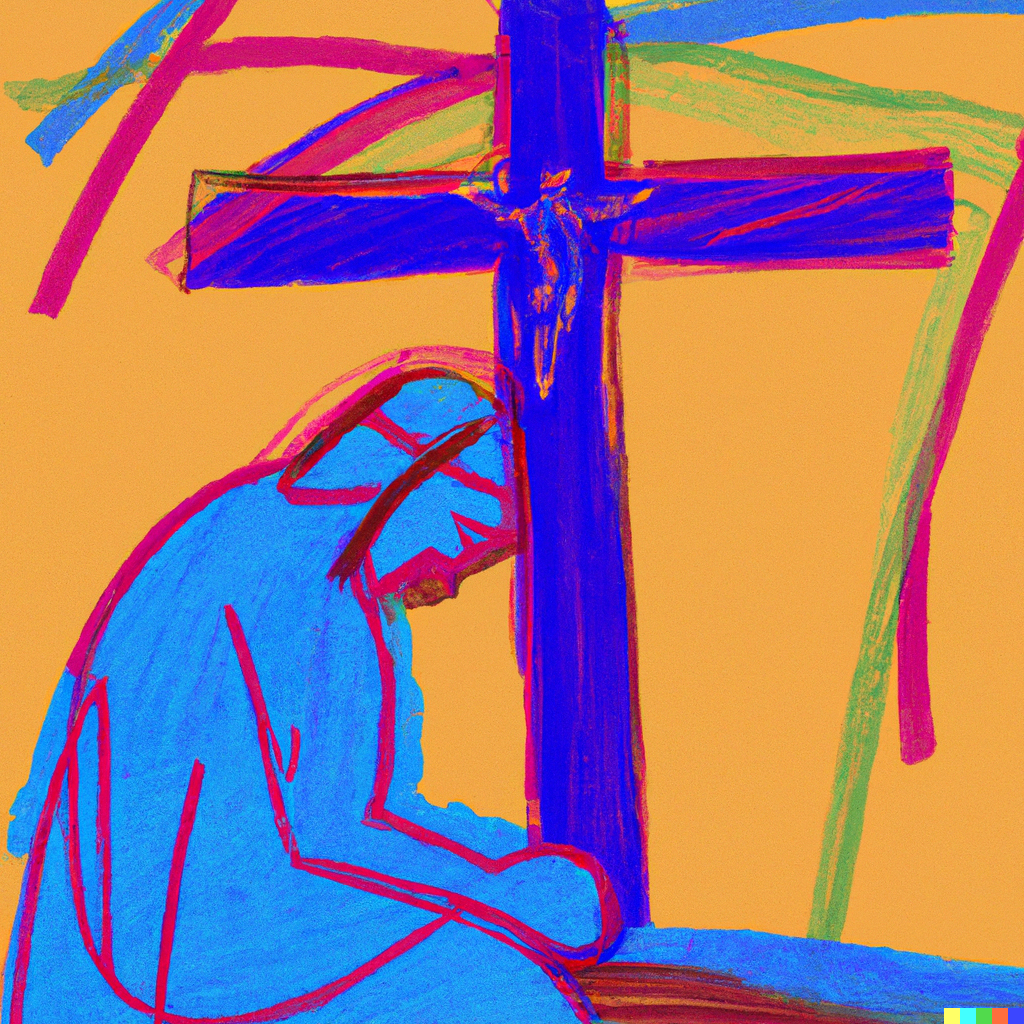Christian Art | A Boy At Prayer With Jesus And The Holy Spirit | Easter To Pentecost
Office Of Readings | Eastertide Week 6, Tuesday | A Reading From The Commentary Of Saint Cyril Of Alexandria On Saint John’s Gospel | Jesus Christ Is The Bond Of Unity
‘Jesus Christ is the bond of unity.’
What Binds Us Together Is Jesus Christ
Saint Cyril of Alexandria draws attention in this reading to the spiritual and sacramental union of believers with Christ and one another. His theology, formed during the height of the Trinitarian and Christological controversies of the fourth and fifth centuries, centres on the mystery of the Incarnation and the salvific unity it brings to humanity. This passage illustrates a core tenet of Cyril’s thinking: that through Christ’s incarnation and the indwelling of the Holy Spirit, the faithful are mystically united both with Jesus Christ and with each other.
Theological Foundation | Communion In Jesus Christ’s Flesh
Saint Cyril begins by affirming that believers participate in a bodily union with Christ ‘to the extent that we partake of his holy flesh’. This refers explicitly to the Eucharist, understood not merely as a symbol but as the real presence of Christ in the bread and wine, a teaching strongly upheld in the early Church. The Eucharist is not only a means of communion with Christ but a bond of unity among all who receive it. Saint Paul echoes this in 1 Corinthians 10:17:
‘Because there is one bread, we who are many are one body, for we all partake of the one bread.’
Cyril insists that this shared participation transforms the community into a single, mystical body. Christ’s incarnate flesh, in which the divine and human are united, becomes the instrument and substance of ecclesial unity.
Unity Through The One Spirit
Cyril transitions from the unity of the body to the unity of the Spirit. Just as the Eucharist makes us one Body, the Holy Spirit makes us one soul. Drawing from Ephesians 4:4–6, he describes the Holy Spirit as indivisible, yet fully present in each believer, knitting them together in one spiritual reality.
This echoes the Nicene Creed’s proclamation of the Spirit as ‘the Lord, the giver of life’, who proceeds from the Father (and the Son), and who is worshipped and glorified with them. Cyril develops the idea that unity is not merely organizational or emotional, but ontological—believers are actually changed in their very being by the Spirit. The Spirit is not external; He enters, transforms, and unites.
This unity is Trinitarian. As the Spirit brings us into communion with Christ, and Christ brings us to the Father, we are drawn into the very life of the Trinity.
Incarnational Implications | The Humanity And Divinity Of Christ
Cyril’s understanding of unity is deeply incarnational. He was a champion of orthodox Christology, defending the teaching that Christ is one Person with two natures (divine and human), perfectly united. It is precisely because Christ is both God and man that he is the perfect mediator and the one in whom unity is possible.
By uniting humanity to himself in the Incarnation, Christ has made it possible for humanity to be united to God. Thus, the Church’s unity is a reflection of the hypostatic union—the divine and human in Christ—extended mystically to all believers.
The Church As The One Body
Cyril’s ecclesiology—his theology of the Church—is deeply grounded in Pauline theology. The Church is not just a collection of individuals but one Body in Christ. The ‘mystical body’ metaphor, developed by Paul and inherited by Cyril, conveys the truth that we share one faith, one baptism, one hope, and one Lord.
Cyril highlights Paul’s exhortation:
‘Bear with one another charitably… Do all you can to preserve the unity of the Spirit by the peace that binds you together’ (Eph 4:2–3).
This unity is not automatic. It is a gift of the Spirit, but also a task entrusted to believers. The Church’s visible unity—expressed in love, patience, and forgiveness—is a sign of the Spirit’s work.
Transformation Into The Divine Nature
One of the most striking aspects of Cyril’s commentary is his emphasis on divinization (theosis)—the belief that human beings are called to participate in the divine nature (cf. 2 Peter 1:4). He writes:
‘We are no longer mere men, but sons of God and citizens of Heaven, through becoming partakers of the divine nature.’
This transformation does not mean the loss of humanity, but its elevation. By conforming to the life of the Spirit, believers are reshaped into the image of Christ. This is a central theme of Eastern Christianity and was shared by other Church Fathers like Athanasius, who famously said:
‘God became man so that man might become god.’
Thus, unity with God and with others is not only ethical or relational—it is ontological. We become something new, a new creation in Christ.
Modern Reflection And Application
In a world marked by division, polarization, and fragmentation, Cyril’s vision offers a counter-cultural proclamation: unity is possible because Christ has already made it real. The Church’s call is to live out what is already true in the sacraments and in the Spirit.
This reading also has strong ecumenical implications. The shared Eucharist and the indwelling Spirit remain the foundational hopes for restoring Christian unity. Moreover, it challenges believers to live in a way that reflects their spiritual identity—citizens of heaven, not merely of earth.
Finally, it invites personal transformation. The unity of the Church begins in the transformation of each soul, surrendering to the Spirit, dying to selfishness, and rising into new life in Jesus Christ.

A Reading From The Commentary Of Saint Cyril Of Alexandria On Saint John’s Gospel | What Binds Us Together Is Jesus Christ
Paul bears witness to the fact that we achieve bodily union with Christ to the extent that we partake of his holy flesh. About this great mystery he says: This that has now been revealed through the Spirit to his holy apostles and prophets was unknown to any men in past generations: it means that pagans now share the same inheritance, that they are parts of the same body, and that the same promise has been made to them, in Jesus Christ.
If we are all the same body with one another in Christ – not just with one another, but with him who, through communion with his flesh, is actually within us – are we not then all of us clearly one with one another and one with Christ? For Christ is the bond that unites us, being at once God and Man.
Following the same line of thought, we can say this about spiritual unity: we all receive one and the same Spirit, I mean the Holy Spirit. So in a way we are blended together with one another and with God. Even though we are many individuals and Christ, the Spirit of the Father and his own Spirit, dwells in each one of us individually, still the Spirit is really one and indivisible. And so that one Spirit binds together the separated spirits of each one of us so that we are seen to be one, together in Christ.
Just as the power of Christ’s holy flesh makes into one body everyone in whom it exists, in the same way the Spirit of God, being indivisible, ties together the spirits in which it dwells.
Again, Paul emphasized this point: Bear with one another charitably, in complete selflessness, gentleness and patience. Do all you can to preserve the unity of the Spirit by the peace that binds you together. There is one Body, one Spirit, just as you were all called into one and the same hope when you were called. There is one Lord, one faith, one baptism, and one God who is Father of all, over all, through all and within all. As the one Spirit abides in us, the one God and Father will be with us through the Son, leading those who share the Spirit into unity with each other and with himself.
There is another way to show that we are united through sharing in the Holy Spirit. If we abandon living as mere animals and surrender ourselves wholly to the laws of the Spirit, it is surely beyond question that by effectively denying our own life and taking upon ourselves the transcendent likeness of the Holy Spirit who is joined to us, we are practically transformed into another nature. We are no longer mere men, but sons of God and citizens of Heaven, through becoming partakers of the divine nature.
We are all, therefore, one in the Father, and the Son, and the Holy Spirit; one because we have the same relationship, one because we live the same life of righteousness, and one in receiving the holy flesh of Christ and in sharing the one Holy Spirit.

Glossary Of Terms
Eucharist: The sacrament of the Body and Blood of Christ.
Incarnation: The doctrine that the Word (Jesus Christ) became flesh.
Mystical Body of Christ: The Church as spiritually united in and through Christ.
Hypostatic Union: The union of divine and human natures in the one Person of Christ.
Pneumatology: Theology of the Holy Spirit.
Divinization (Theosis): Participation in the divine nature through grace.
Ecclesiology: Theology of the Church.
Patristic: Relating to the Church Fathers.
Prayer With Jesus
Lord Jesus Christ,
You are the source of our unity, the Word made flesh, and the giver of the Spirit.
Bind us together in the love that flows from your sacred heart.
Draw us deeper into communion with you in the Eucharist,
And transform our hearts to be vessels of peace, patience, and mercy.
Holy Spirit, make us one in faith, one in hope, and one in love.
May the Church truly reflect the unity of your Body,
And may we live not for ourselves, but for you,
Partakers of your divine nature and citizens of heaven.
Amen.







